Urban Fire Risk Dynamics and Mitigation Strategies in Shanghai: Integrating Spatial Analysis and Game Theory
Abstract
1. Introduction
2. Materials and Methods
2.1. Study Area
2.2. Method
2.2.1. Spatial and Temporal Distribution Characteristics
- (1)
- Morlet wavelet analysis
- (2)
- Kernel Density Estimation
2.2.2. Urban Fire Risk Assessment System
- (1)
- Indicator selection
- (2)
- Weight calibration
- (3)
- Urban fire risk assessment model
2.3. Data Sources
3. Results
3.1. Temporal Distribution of Urban Fires
3.2. Spatial Distribution of Urban Fire
3.3. Urban Fire Risk Assessment
3.3.1. Comprehensive Evaluation of Fire Risk in Shanghai
3.3.2. Spatial Distribution of Indicators
4. Discussion
4.1. The Main Factors Affecting the Occurrence of Fire in Shanghai
4.2. Effects of Urban Greening on Fire Risk and Countermeasures
5. Conclusions
Author Contributions
Funding
Data Availability Statement
Conflicts of Interest
References
- Manzello, S.L.; Suzuki, S. The importance of combustion science to unravel complex processes for informal settlement fires, urban fires, and wildland-urban interface (WUI) fires. Fuel 2022, 314, 122805. [Google Scholar] [CrossRef]
- Zhang, W.H.; Shen, R.F. The summary, logical limitations and countermeasures of urban fire risk cognition. Syst. Eng. Theory Pract. 2019, 39, 387–396. [Google Scholar]
- Ryu, S.R.; Choi, H.T.; Lim, J.H.; Lee, I.K. Post-fire restoration plan for sustainable forest management in South Korea. Forests 2017, 8, 188. [Google Scholar] [CrossRef]
- Corcoran, J.; Higgs, G.; Brunsdon, C.; Ware, A.; Norman, P. The use of spatial analytical techniques to explore patterns of fire incidence: A South Wales case study. Comput. Environ. Urban Syst. 2007, 6, 623–647. [Google Scholar] [CrossRef]
- Zhang, X.; Yao, J.; Sila-Nowicka, K. Exploring spatiotemporal dynamics of urban fires: A case of Nanjing, China. ISPRS Int. J. Geo-Inf. 2018, 7, 7. [Google Scholar] [CrossRef]
- Wang, X.D.; Yang, S.; Zhang, S.Y.; Luo, W.Y.; Li, J.; Liu, H. Urban Fire Risk Prediction Based on Spatial-Temporal Big Data and Satellite Images. Comput. Eng. 2023, 6, 242–249. [Google Scholar]
- Bertrand, A.L.; Mckenzie, L.S. The Human Factor in High Fire Risk Urban Residential Areas: A Pilot Study in New Orleans, Louisiana; US Department of Commerce, National Fire Prevention and Control Administration: Washington, DC, USA, 1976. [Google Scholar]
- Zong, X.Z.; Tian, X.R.; Liu, C. Method and application of forest fire risk assessment on forest stand scale. For. Res. 2021, 34, 69–78. [Google Scholar]
- Fu, X.Q. A review of fire risk assessment methods in urban areas. Fire Sci. Technol. 2021, 11, 1622–1625. [Google Scholar]
- Ma, L.; Liu, H.; Bai, L. Fire risk assessment of the historic buildings based on AHP and entropy weight method. J. Xi’an Univ. Sci. Technol. 2017, 4, 537–543. [Google Scholar]
- Aksoy, E.; Kocer, A.; Yilmaz, İ.; Akcal, A.N.; Akpinar, K. Assessing Fire Risk in Wildland–Urban Interface Regions Using a Machine Learning Method and GIS data: The Example of Istanbul’s European Side. Fire 2023, 6, 408–433. [Google Scholar] [CrossRef]
- Pei, Z.; Li, J.; Guo, J.; Li, Q.; Chen, J. Using local co-location quotient and niche-based model to assess fire risk in urban environments: A case study of Beijing, China. Sustain. Cities Soc. 2023, 99, 104989. [Google Scholar] [CrossRef]
- Polinova, M.; Wittenberg, L.; Kutiel, H.; Brook, A. Reconstructing pre-fire vegetation condition in the wildland urban interface (WUI) using artificial neural network. J. Environ. Manag. 2019, 238, 224–234. [Google Scholar] [CrossRef] [PubMed]
- Knapp, E.E.; Valachovic, Y.S.; Quarles, S.L.; Johson, N.G. Housing arrangement and vegetation factors associated with single-family home survival in the 2018 Camp Fire, California. Fire Ecol. 2021, 17, 25. [Google Scholar] [CrossRef]
- Artan, H. Indexing the vegetated surfaces within WUI by their wildfire ignition and spreading capacity, a comparative case from developing metropolitan areas. Int. J. Disaster Risk Reduct. 2021, 63, 102434. [Google Scholar]
- Maria, M.; Lea, W.; Haim, K.; Brook, A. A novel urban vegetation mapping approach for fire risk assessment: A Mediterranean case study. Urban Ecosyst. 2023, 26, 1263–1274. [Google Scholar]
- Jiang, R.; Chen, L.; Xiang, W.N. Characteristics of extreme high temperature weather in Shanghai. J. Meteorol. Environ. 2016, 32, 66–74. [Google Scholar]
- Li, X.F.; Tan, X.; Qian, Z. Analysis and assessment of urban waterlogging risk in Shanghai. China Flood Drought Manag. 2024, 34, 26–32. [Google Scholar] [CrossRef]
- Aguilar-Velazouez, D.; Reyes-Ramirez, I. A wavelet analysis of multiday extreme ozone and its precursors in Mexico City During 2015–2016. Atmos. Environ. 2018, 188, 112–119. [Google Scholar] [CrossRef]
- Atsuyuki, O.; Toshiaki, S.; Kokichi, S. A kernel density estimation method for networks, its computational method and a GIS-based tool. Int. J. Geogr. Inf. Sci. 2009, 23, 7–32. [Google Scholar]
- Shi, P.J. Theory and practice on disaster system research in a fourth time. J. Nat. Disasters 2005, 14, 5–11. [Google Scholar]
- Su, G.Q.; Lv, H.S.; Zhu, Y.H.; Chen, T.X.; Hua, J.C. Flood risk assessment based on game theory combination weighting: A case study of Wuwei Area. Arid. Zone Res. 2022, 39, 801–809. [Google Scholar]
- Li, X.T.; Liu, Q.; Qian, X.L.; Liu, S.C.; Wang, C.Y. Method for national fuel types classification based on multi-source data. Natl. Remote Sens. Bull. 2022, 26, 480–492. [Google Scholar] [CrossRef]
- Gissi, E.; Manea, E.; Mazaris, A.D.; Fraschetti, S.; Katsanevakis, S. A review of the combined effects of climate change and other local human stressors on the marine environment. Sci. Total Environ. 2020, 755, 142564. [Google Scholar] [CrossRef]
- Ma, L.; Huang, X.; Gao, J.X.; Miao, J.M.; Zhang, P.Y. Distribution law and probability density prediction of urban area fire events. J. Xi’an Univ. Sci. Technol. 2022, 42, 260–267. [Google Scholar]
- Zhu, R.L. Fire Resistance Evaluation of Plant Communities Based on the Spatial Structure of Fire Spread. Master’s Thesis, Tongji University, Shanghai, China, 2023. [Google Scholar]
- Gao, F.; Du, M.Y.; Liang, M.Y. Fire Risk Evaluation System and Its Application in Planning of Urban Fire Control from the Space-temporal Perspective. Planners 2023, 39, 128–133. [Google Scholar]
- Li, H.Q.; Zhang, D.S. Research on Fireproof Landscape Plants: Progress and Prospect. J. Chin. Urban For. 2022, 20, 133–139. [Google Scholar]
- Chen, C.J.; Shi, X.F.; Hu, H.; Deng, S.F.; Huang, Y.L. Study on tree species selection in fireproof forest belt. J. Fujian For. Coll. 1988, 1, 1–12. [Google Scholar]
- Zhang, D.S.; Chen, Y.J.; Wu, X.; Zhang, B.C.; Yao, C.Y. Correlation between morphological characteristics and fire-retardant capabilities of landscape trees. J. Chin. Urban For. 2020, 18, 23–28. [Google Scholar]
- Fernández-Álvarez, M.; Armesto, J.; Picos, J. LiDAR-Based Wildfire Prevention in WUI: The automatic detection, measurement and evaluation of forest fuels. Agric. Week 2019, 10, 148. [Google Scholar] [CrossRef]
- Zhang, Y.N.; Huang, L.X.; Wen, X.Y.; Yang, D.; Ning, S.Y. Research status and prospect of fire disaster based on bibliometric method. J. Saf. Sci. Technol. 2022, 18, 181–188. [Google Scholar]
- Zhang, D.S.; Wu, X.; Chen LQ, Y.; Hu, L.H.; Li, K.K.; Zhan, Y.; Yao, C.Y. Combustibility Evaluation of 26 Landscape Tree Species in Shanghai. J. Tongji Univ. Nat. Sci. 2021, 49, 1399–1406. [Google Scholar]
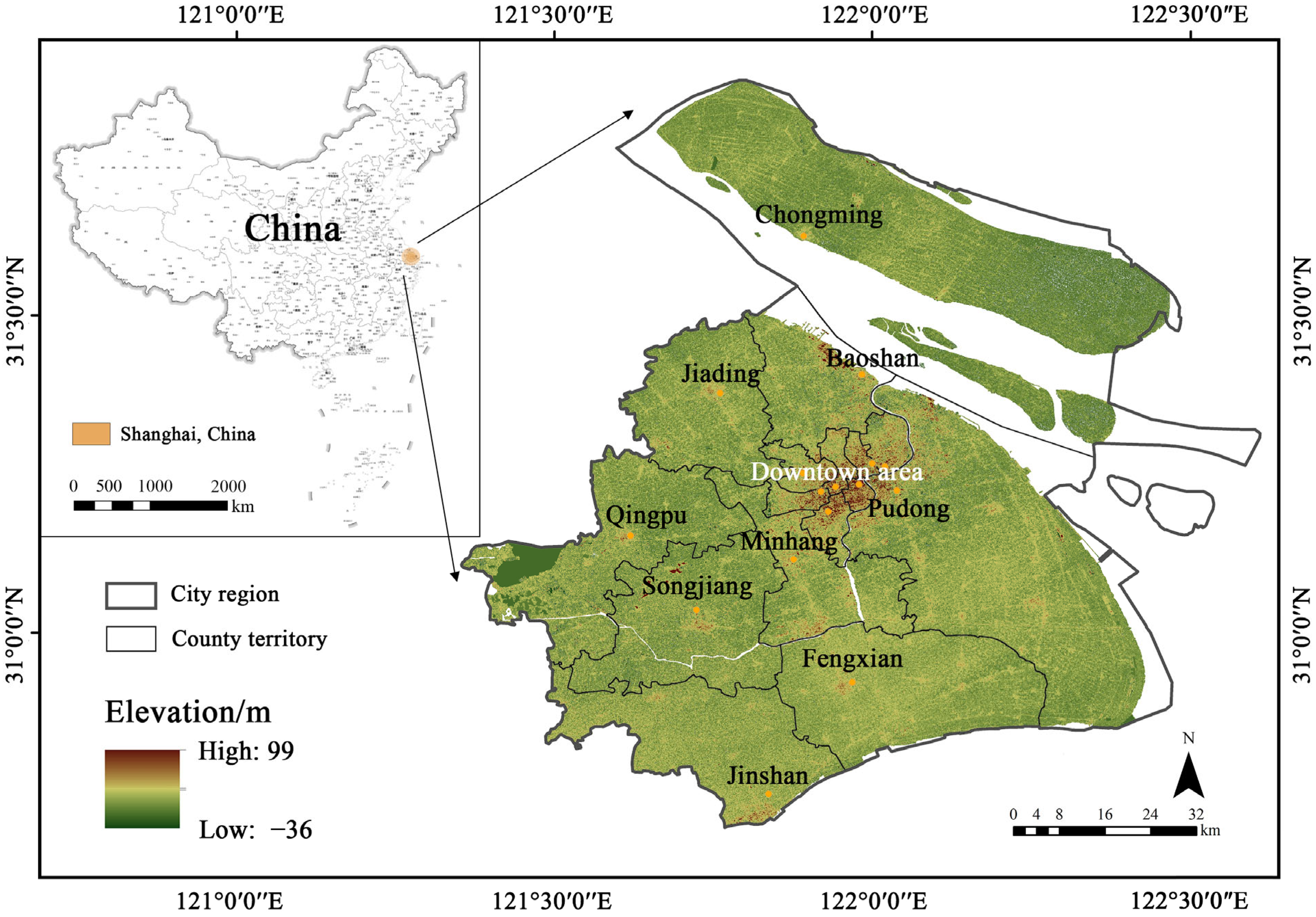
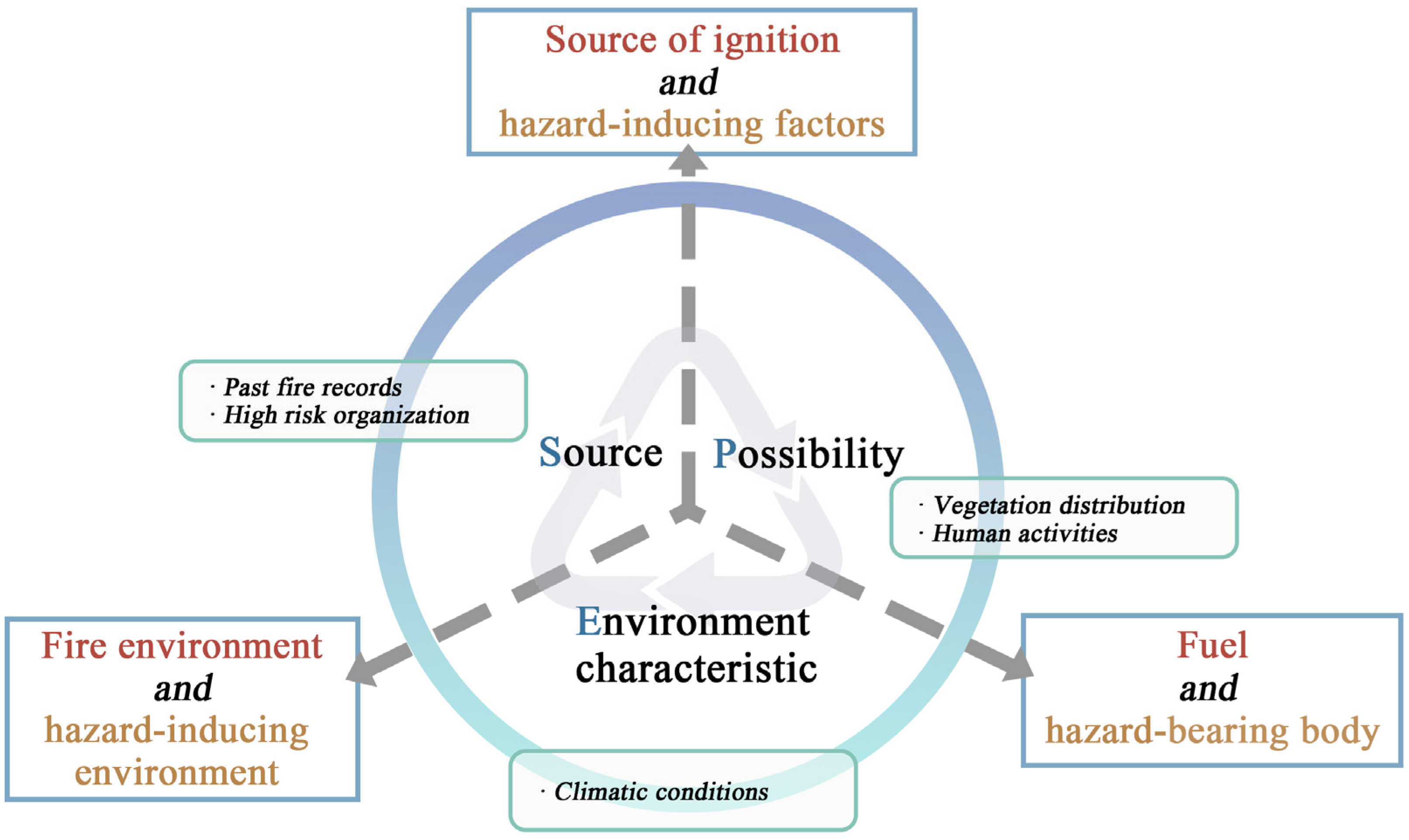
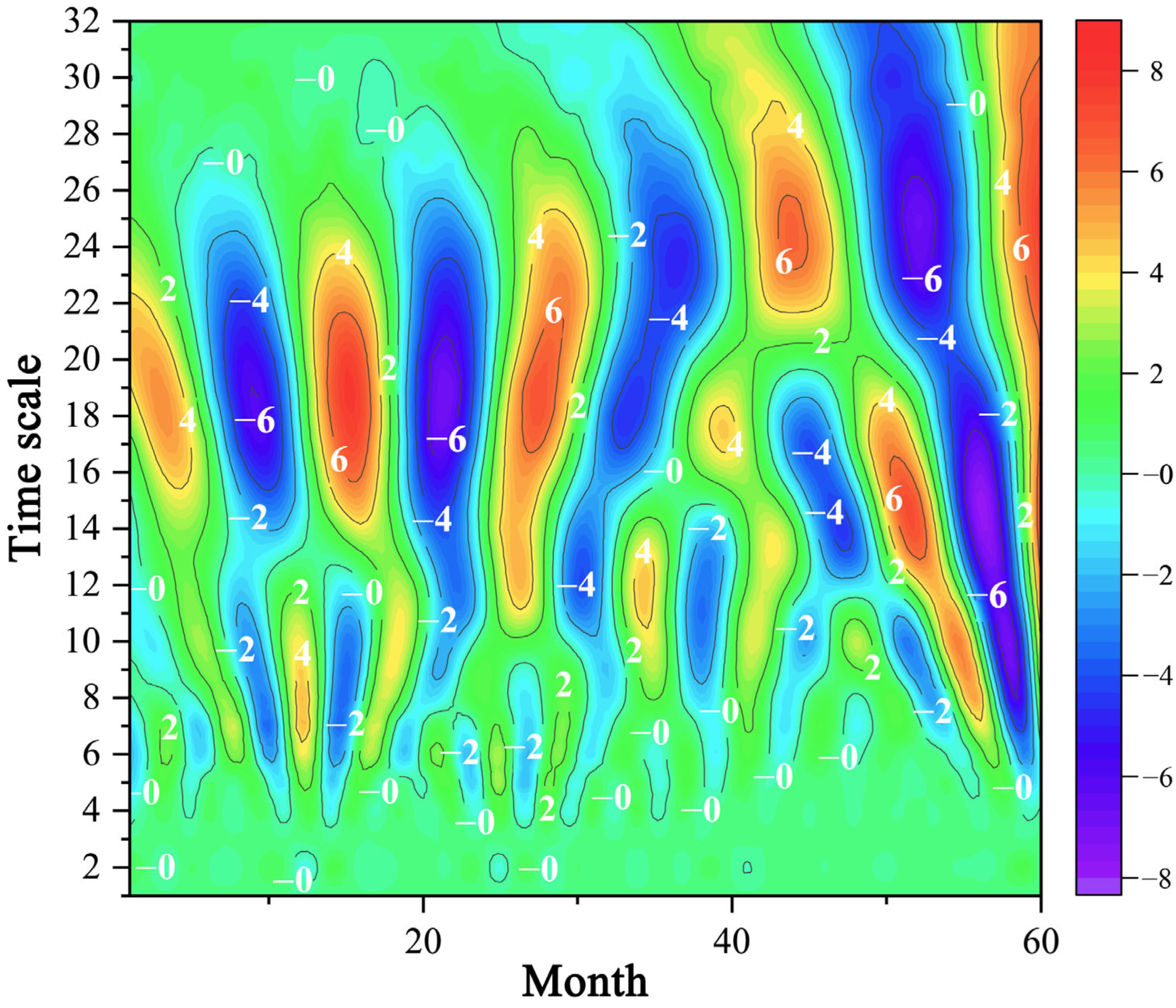

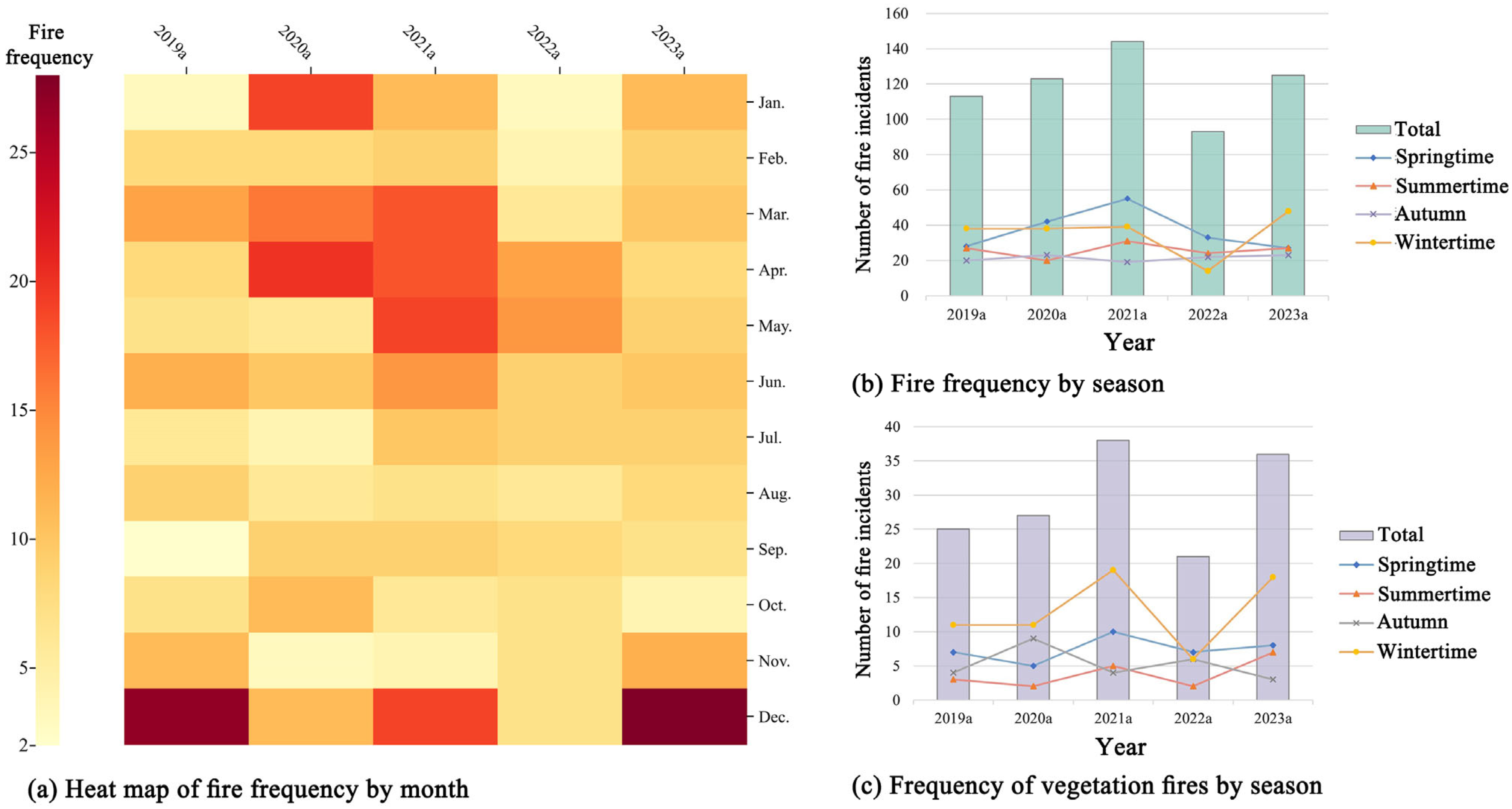
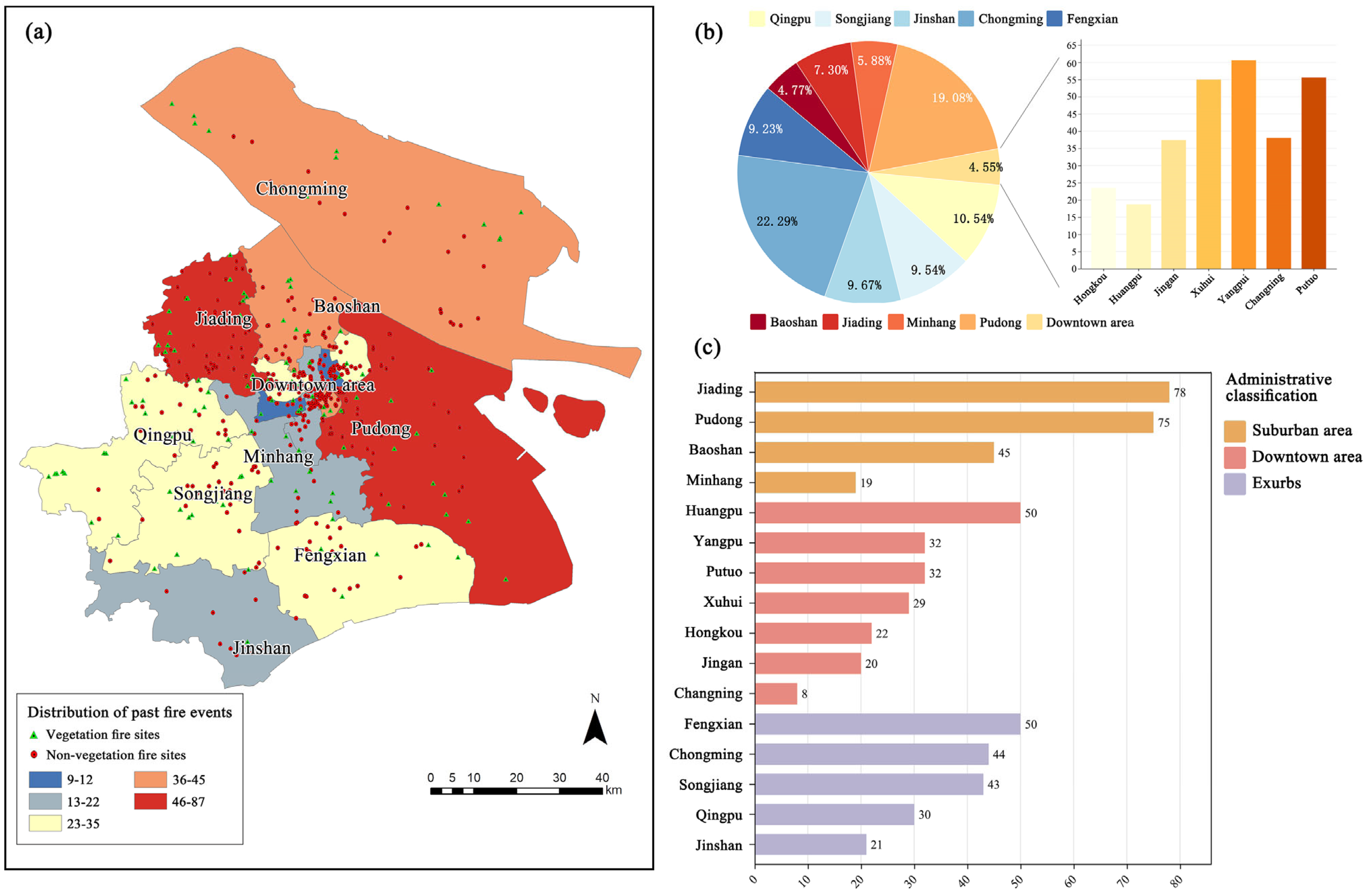
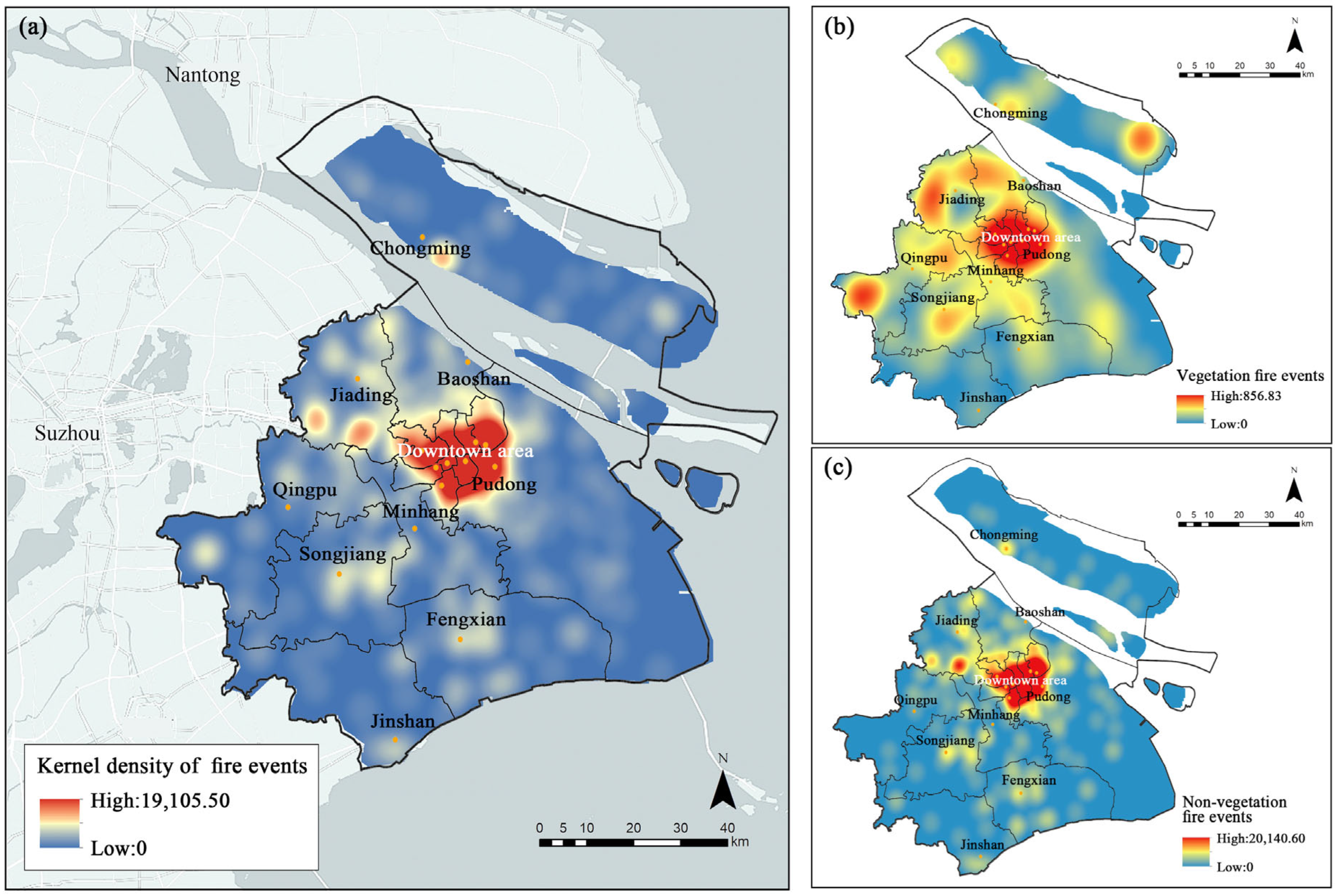
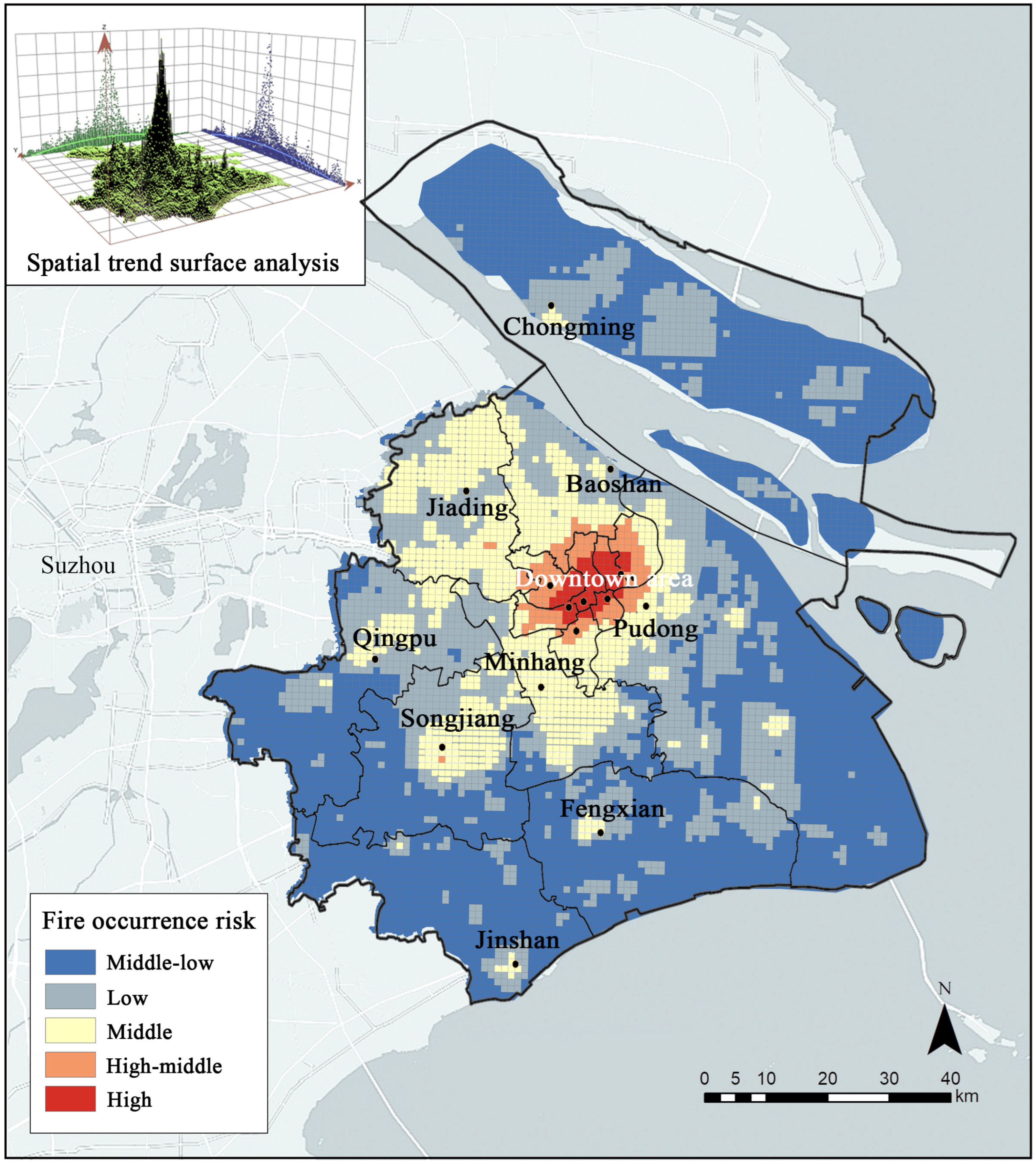
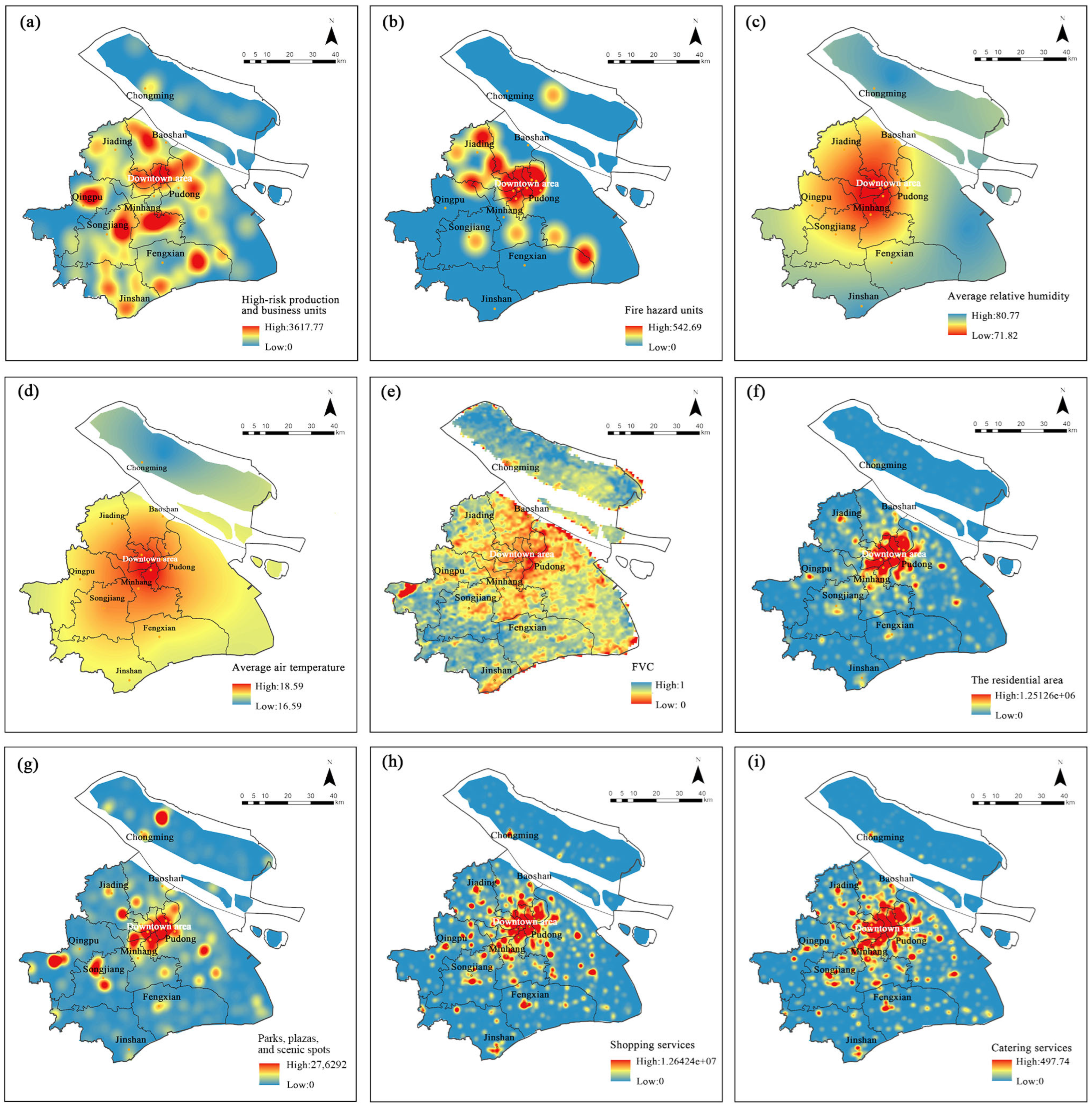
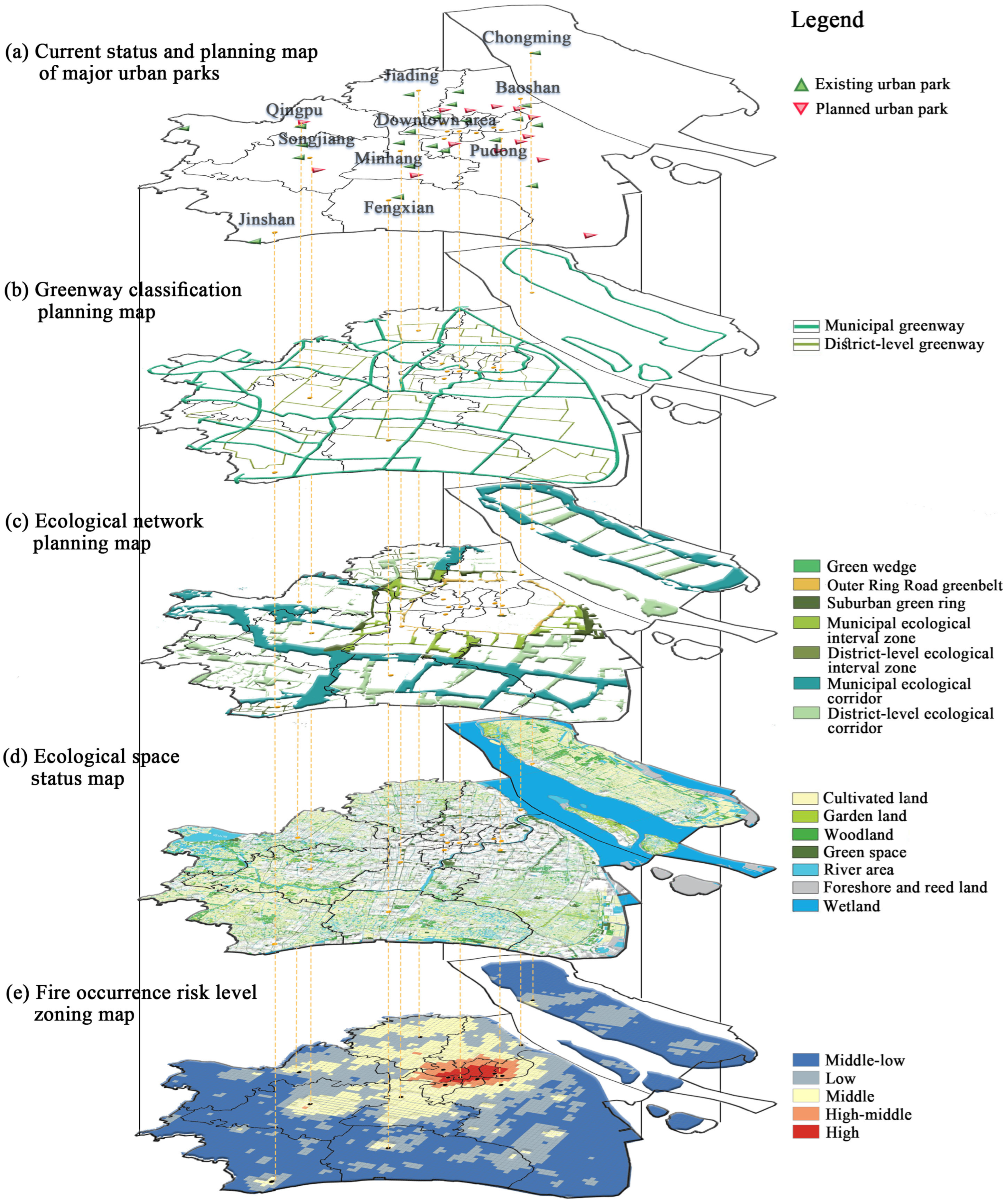
| Data | Spatial Scale | Data Sources |
|---|---|---|
| Satellite fire data | / | SatSee-Fire (http://satsee.radi.ac.cn:8080/index.html, accessed on 24 May 2024) |
| Fire notification | / | Shanghai Fire Rescue Corps (https://www.weibo.com/shanghaixiaofang, accessed on 2 April 2024) |
| High-risk production and business units | / | Shanghai Emergency Management Bureau (https://yjglj.sh.gov.cn/, accessed on 10 April 2024) |
| Fire hazard units | / | Shanghai Emergency Management Bureau (https://yjglj.sh.gov.cn/, accessed on 10 April 2024) |
| Average annual relative humidity | / | National Meteorological Information Center (http://data.cma.cn, accessed on 12 May 2024) |
| Annual mean temperature | / | National Meteorological Information Center (http://data.cma.cn, accessed on 12 May 2024)) |
| Points of interest in human activities | / | Amap open platform (https://lbs.amap.com/, accessed on 5 February 2024) |
| NDVI | 500 m | National Earth System Science Data Center and US Geological Survey (http://www.usgs.gov/, accessed on 19 February 2024) |
| Status quo of ecological space in Shanghai | / | Shanghai Bureau of Planning and Natural Resources (https://ghzyj.sh.gov.cn/, accessed on 24 May 2024) |
| Shanghai greenway classification planning | / | Shanghai Bureau of Planning and Natural Resources (https://ghzyj.sh.gov.cn/, accessed on 24 May 2024) |
| Planning of ecological network in Shanghai | / | Shanghai Bureau of Planning and Natural Resources (https://ghzyj.sh.gov.cn/, accessed on 24 May 2024) |
| Factors | Indicators | Type | Weights | ||
|---|---|---|---|---|---|
| AHP | EM | Combined | |||
| Source | Density of high-risk production and business units | Positive | 0.205 | 0.058 | 0.145 |
| Density of fire hazard units | Positive | 0.236 | 0.153 | 0.202 | |
| Density of vegetation fire sites | Positive | 0.058 | 0.138 | 0.091 | |
| Density of non-vegetation fire sites | Positive | 0.049 | 0.051 | 0.050 | |
| Environmental characteristics | Average annual relative humidity | Negative | 0.068 | 0.004 | 0.042 |
| Annual mean temperature | Positive | 0.062 | 0.004 | 0.039 | |
| Possibility | Fractional Vegetation Cover | Positive | 0.070 | 0.058 | 0.066 |
| Density of residential area | Positive | 0.137 | 0.154 | 0.15 | |
| Density of shopping services | Positive | 0.024 | 0.132 | 0.068 | |
| Density of food service venues | Positive | 0.028 | 0.139 | 0.074 | |
| Density of scenic spots and park squares | Positive | 0.062 | 0.108 | 0.081 | |
| Risk Level | Area (km2) | Proportion (%) | ||||
|---|---|---|---|---|---|---|
| AHP | EM | Combined | AHP | EM | Combined | |
| Middle-low | 801.44 | 4217.83 | 3013.01 | 12.64 | 66.52 | 47.52 |
| Low | 3465.08 | 1565.25 | 2178.60 | 54.65 | 24.69 | 34.36 |
| Middle | 659.41 | 405.80 | 959.32 | 10.40 | 6.40 | 15.13 |
| High-middle | 1297.27 | 103.31 | 125.54 | 20.46 | 1.63 | 1.98 |
| High | 117.30 | 48.31 | 64.04 | 1.85 | 0.76 | 1.01 |
Disclaimer/Publisher’s Note: The statements, opinions and data contained in all publications are solely those of the individual author(s) and contributor(s) and not of MDPI and/or the editor(s). MDPI and/or the editor(s) disclaim responsibility for any injury to people or property resulting from any ideas, methods, instructions or products referred to in the content. |
© 2024 by the authors. Licensee MDPI, Basel, Switzerland. This article is an open access article distributed under the terms and conditions of the Creative Commons Attribution (CC BY) license (https://creativecommons.org/licenses/by/4.0/).
Share and Cite
Yao, M.; Zhang, D.; Chen, Y.; Liu, Y.; Elsadek, M. Urban Fire Risk Dynamics and Mitigation Strategies in Shanghai: Integrating Spatial Analysis and Game Theory. Land 2024, 13, 1125. https://doi.org/10.3390/land13081125
Yao M, Zhang D, Chen Y, Liu Y, Elsadek M. Urban Fire Risk Dynamics and Mitigation Strategies in Shanghai: Integrating Spatial Analysis and Game Theory. Land. 2024; 13(8):1125. https://doi.org/10.3390/land13081125
Chicago/Turabian StyleYao, Manqing, Deshun Zhang, Yingying Chen, Yujia Liu, and Mohamed Elsadek. 2024. "Urban Fire Risk Dynamics and Mitigation Strategies in Shanghai: Integrating Spatial Analysis and Game Theory" Land 13, no. 8: 1125. https://doi.org/10.3390/land13081125
APA StyleYao, M., Zhang, D., Chen, Y., Liu, Y., & Elsadek, M. (2024). Urban Fire Risk Dynamics and Mitigation Strategies in Shanghai: Integrating Spatial Analysis and Game Theory. Land, 13(8), 1125. https://doi.org/10.3390/land13081125










